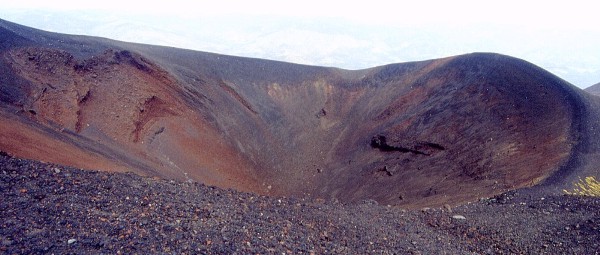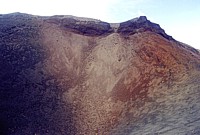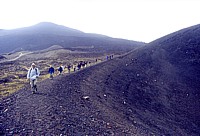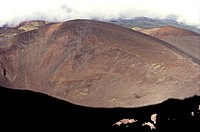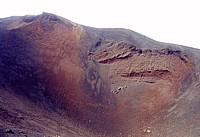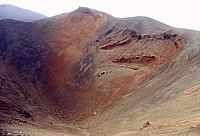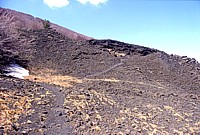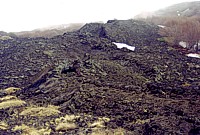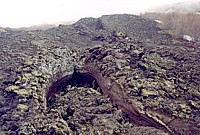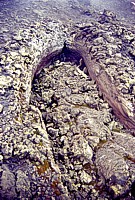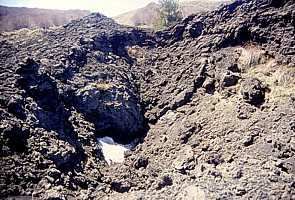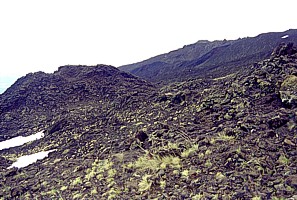| Etna
index |
||
| Geology | Geological history | Cones and craters |
| Eruptive characteristics | Eruptions before 1971 | Eruptions since 1971 |
| Etna and Man | References | Web sites |
| Weather forecasts | FAQ | Latest news |
Mamma
Etna's countless children
1879 craters and eruptive fissure
NE flank, 15.012421° E, 37.794226° N
Summit elevation: 2332 m (E rim of largest crater)
![]()
In
late May and early June 1879, a spectacular and complex eruption occurred
at Mount Etna. The activity started high on the southwest flank of the
volcano and then extended across the summit to the Northeast Rift, where
intense explosive activity high on the rift was accompanied by lava emission
from a fissure segment about 2 km further downrift (to the west of Monte
Nero). The exact location of the main explosive vents has been subject
to a major error, made after the eruption and maintained in nearly all
publications (including topographic maps) through today. In fact, the
large explosion craters formed during that eruption were named "Crateri
Umberto e Margherita" after the then-reigning King of Italy and his
wife; this name was subsequently applied to a pair of craters lying about
1.3 km northeast of Monte Pizzillo, and in a much more easterly position
than the trend of the lowermost portion of the 1879 fissure near Monte
Nero. From contemporary sources describing the eruption, Tanguy (1979)
inferred that the explosive vents of the 1879 eruption lay actually somewhat
higher on the Northeast Rift, on the northeastern and eastern flank of
Monte Pizzillo and coincide with two impressive craters that bite deeply
in the older Monte Pizzillo cone. Eyewitness accounts of the 1879 eruption
emphasize on the unusually strong explosive activity, which caused heavy
ash falls in surrounding areas. In his re-examination of the event, Tanguy
(1979) found that the two craters indicated on more recent topographic
maps as "Crateri Umberto e Margherita" are too small to correspond
to the descriptions of such a strong explosive activity, whereas the two
large craters on the side of Monte Pizzillo fit that description quite
well. Furthermore the contemporary reports place the site of the explosive
activity rather in that area than further downrift, and finally the "Crateri
Umberto e Margherita" lie too far east to coincide with the trend
of the 1879 fissure, whereas the craters near Monte Pizzillo lie exactly
on that trend.
The two craters on the eastern-northeastern side of Monte Pizzillo are
truly of huge proportions, testifying to extraordinarily strong explosive
activity. The smaller and more southerly (uprift) of the craters has a
diameter of about 180 m and a depth of 30 m below its low east rim and
70 m below the high W rim (which coincides with the summit of Monte Pizzillo).
Immediately to the NNE lies the second and much larger crater, with a
maximum depth of 70 m and a N-S diameter of 350 m while the E-W diameter
is about 260 m. In spite of the size of these craters and the intense
explosive activity, no major pyroclastic cones were built around them;
their activity was rather destructive since it tore away much of the eastern-northeastern
flank of Monte Pizzillo. In some places in the walls of the 1879 craters
there are outcrops of pre-exisiting pyroclastic deposits that were laid
down first during the eruption that created Monte Pizzillo in A.D. ~970
and then by another eruption that opened a new crater on the north side
of Monte Pizzillo.
My first visit to the 1879 craters was in September 1999 and I returned
three years later. The photos on this page were taken during those visits.
In contrast, I visited the lower effusive vents near Monte Nero in May
2000 and again in May 2002 and July 2003.
About 2 km downrift from the large explosion craters, and about 400 m west of Monte Nero, there lies the lower end of the 1879 fissure system on the northeast flank of Etna. These are constituted by low spatter mounds and ramparts that occupy the lower portion of the channel on the east side of Monte Timparossa. Several effusive vents emitted lava that merged into a narrow flow, which advanced rapidly toward the Alcantara valley and eventually reached a total length of 9.5 km.
Continue to Monte Cacciatore
Copyright © Boris Behncke, "Italy's Volcanoes: The Cradle of Volcanology"
Page set up on 23 February 2004

